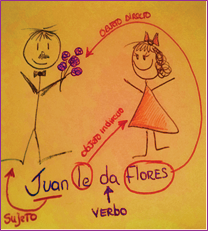Unidad 4: Estudiando en el extranjero
6. Estrategias para la comunicación escrita: Evitando la redundancia
In Spanish it is important that you avoid redundancy. There are a couple of tips that can help you with this, the objective is to make your text more pleasing to read.
First: Use the personal pronouns only when you would like to emphasize. In Spanish, if you constantly use the personal pronouns such as “yo”, it can give the perception of the speaker being presumptuous and self-promoting. This is interpreted in a negative way culturally.
Yo camino en el parque, yo estudio español, yo tengo dos hermanas, yo, yo, yo
Second: Use the direct and indirect object pronouns to avoid needless repetition.
¿Piensas comprarle un pastel a tu mamá? Sí pienso comprarle un pastel a mi mamá.
¿Piensas comprarle un pastel a tu mamá? Sí pienso comprárselo. This avoids redundancy.
| Direct object pronouns—answer who or what in the predicate of the sentence | Indirect object pronouns—answer to whom or for whom in the predicate of the sentence. | ||||
|---|---|---|---|---|---|
| Me | me | Me visitas à you visit me | Me | to me
for me |
Me das el mensaje à You give to me the message. |
| Te | you | Te visito à I visit you | Te | to you
for you |
Te doy el mensaje à I give to you the message. |
| Lo/la | it/him/
her/you |
Lo lees à You read it. (el libro)
La escribes à You write it. (la carta) Lo ves à You see him. La ves à You see her. |
Le
(Se)* |
to him/to her/ to you
for him/for her/for you (when the direct object is lo, la, los, las) |
Le haré un pastel. à I will make for him/her or you a cake. |
| Nos | us | Nos mira à She watches us. | Nos | to or for us | Nos escribes. à You write to us. |
| Os | you all | Os miramos à We watch you all. | Os | to or for you all | Os pagaré. à I will pay for all of you. |
| Los/las |
them | Los quiero à I love them. (mis hijos)
Las necesitamos à We need them. (las plumas)
|
Les
(Se)* |
to or for them
to or for you / to or for all of you to or for them |
Les daremos la comida.
We will give them (to them) the food. |
|
*Se is used when both a direct and indirect object pronoun beginning with ‘L” are in the same sentence. This helps break up the sounds and avoids using the word that means silly. Se la daremos. We will give the food to them.
|
|||||
Third: Use synonyms or antonyms to avoid repetitions. One rule is that you should not use a word two times in the same paragraph. Using synonyms or antonyms can help you to resolve this problem. It helps demonstrate a richer, more robust vocabulary in your speech and written communication.
| Synonyms | Antonyms | |
| Moderno | Actual, Nuevo | Viejo, Anticuado |
| Simpática | Amable, Cordial | Desagradable, antipática |
| Me gusta | Me encanta, Me fascina | Me molesta, Me disgusta |
Let’s see the next example, where the redundancy is present:
Isa es mi mejor amiga. Isa estudia para ser doctora. Mi mejor amiga tiene una hermana en Florida. Su hermana es muy simpática. Su hermana estudia para ser maestra de español. Su hermana tiene un coche nuevo y ella va a venir a visitar a Isa a Geneseo. Yo quiero conocer a la hermana de Isa y también yo quiero tener un coche nuevo.
Now avoid the redundancy: Isa es mi mejor amiga, estudia para ser doctora. Tiene una hermana muy simpática en Florida. Estudia para ser maestra de español. Tiene un coche nuevo y va a venir a visitarla a Geneseo. Quiero conocerla y también me gustaría tener un coche nuevo.
Repasemos cómo evitar la redundancia en preguntas y respuestas: Using the verb conjugations, we have avoided repeating the use of personal pronouns and subjects in the last paragraph. As you studied, In Spanish, the direct and indirect object pronouns are used to avoid redundancy in a question/answer situation. Review the following chart.
| Pronombres personales | Pronombres de objeto directo | Pronombres de objeto indirecto |
|---|---|---|
| yo | me | me |
| tú | te | te |
| él, ella, usted | lo – la | le – se |
| nosotros/as | nos | nos |
| vosotros/as | os | os |
| ellos, ellas, ustedes | los -las | les – se |

POD: responden a la pregunta ¿quién o qué?
¿Qué me da Juan? las flores à objeto directo.
POI: responde a la pregunta ¿a quién o para quién?
¿A quién le da Juan las flores? à a María à objeto indirecto.
Es muy importante que recuerdes qué ocurre cuando tenemos los pronombres de objeto directo e indirecto no los podemos separar, siempre deben de estar juntos. Tampoco puedes olvidar que los pronombres de objeto indirecto en las terceras personas “le/les” cambian a “se” antes de “lo, la, los o las”. Recuerda el orden àID=keep your ID with youàindirect then direct then the verb.

Las siguientes preguntas son para practicar el concepto de los complementos directos e indirectos. Es un repaso del presente del modo indicativo. Contéstalas como el ejemplo.
- ¿Compras las verduras para la sopa? Sí, las compro.
- ¿Utilizas la sal en la receta? ____________________
- ¿Comes el desayuno todos los días? ____________________
- ¿Hacemos la tortilla española para la clase? ____________________
- ¿Quieren los novios el vino con su cena? ____________________
- ¿Visitas a tus padres mucho? ____________________
- ¿Das a ellos un regalo por su cumpleaños? ____________________
- ¿Horneas una torta de chocolate para tus padres? ____________________
- ¿Escribe Ud. muchas recetas para los clientes? ____________________
TAREA: You already have your draft of your email to your parents corrected by your professor. Incorporate the corrections and also, make changes to avoid redundancy. Now type a new version of your email avoiding the redundancy.

